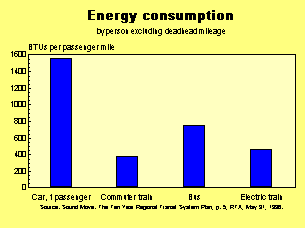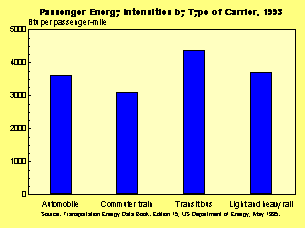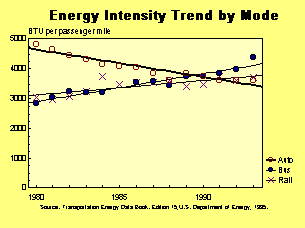
Supplement to Lead Story:
Energy Consumption Data from RTA are Misleading
Despite what may seem obvious, the RTA plan is not going to save energy. This would be true if transit vehicles were always full to capacity and if passenger vehicles carried only the driver. However, transit vehicles make many trips when they are empty or nearly empty. And some trips by private vehicle -- such as commuter carpools and vanpools, as well as weekend family excursions -- carry passengers.
The following charts compare energy consumption data from a principal RTA document (Chart 1) with data collected by the US Department of Energy (Chart 2 and Chart 3). The RTA data are apparently intended to suggest that the private passenger vehicle is much less energy efficient than several forms of urban transit.
Chart 1

Chart 2

Chart 3

The RTA data in Chart 1 have several problems that are apparent if we closely compare it to the federal data. First, RTA data exclude energy used in deadhead trips, i.e., when transit vehicles have finished their scheduled runs and are returning to transit bases. Since many trips, especially long bus trips in peak periods make one or two trips before returning to base, deadheading accounts for a significant portion of their total mileage and energy use. To exclude deadhead mileage would be akin to excluding the return vehicle trip from a drive to the cleaners to drop off clothes, or to leaving off the ride back home after driving a child to school. The federal data in Charts 2 and 3 include all transit mileage, as should be done to reflect true energy efficiency.
Second, the RTA chart compares a one passenger private vehicle with transit vehicles that presumably are loaded to the average number of passengers carried over a measurement period. For Metro buses, the average annual load, weekday and weekend, is approximately 13 passengers. But cars, on average carry more than one passenger. National data indicate that the average auto carries 1.62 persons. If all motorized vehicles are averaged, including passenger vans, utility vehicles, and pickup trucks, the occupancy is 1.64. The energy consumption of the average auto on a per passenger-mile basis should therefore be about 60 percent less that the amount shown in the RTA chart.
The magnitudes of the numbers in Chart 1 also appear to incorrect. The federal data in Chart 2 indicate that energy consumption should be roughly four times greater.
Finally, Chart 3 indicates the trends over time for auto, bus and rail (light and heavy) modes nationwide. Clearly, the increased fuel efficiency of private vehicles (downward sloping line) has more than offset decreasing vehicle occupancy. On the other hand, bus and rail transit, (two upward sloping lines) has become less energy efficient as new systems and new service to low density areas have been added. As a result, transit has no significant advantage over the auto as measured by energy efficiency.